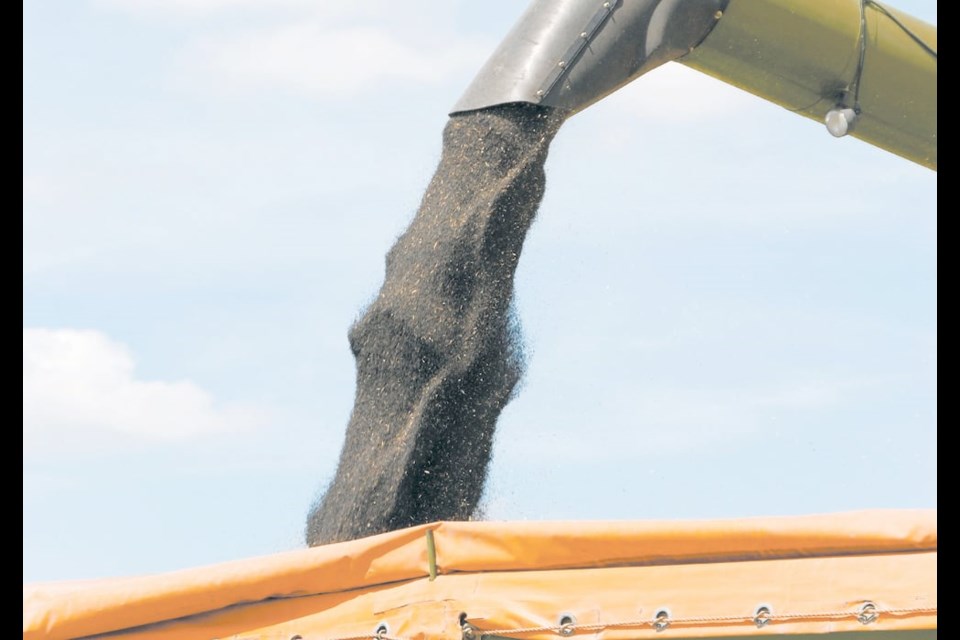WESTERN PRODUCER — Canola futures have fallen throughout autumn, weighed down by falling crude oil and vegetable oil prices and the latest Statistics Canada report that added close to a million tonnes to the production estimate.
Canola production is 18.3 million tonnes according to the Production of Principal Field Crops report, based on a producer survey conducted Oct. 6 to Nov. 12.
That is up from the 17.4 million forecast in the StatCan report that came out in September, which was based on satellite imagery and modelling from August.
The latest report showed crops, including wheat, barley, oats, peas and lentils, were larger than projected in September.
The exception was durum, which was about the same in both reports.
The latest numbers were close to what analysts expected.
Still, the larger canola number in the StatCan report weighed on futures last week.
Less than impressive canola disappearance also weighs on canola.
The Canadian Grain Commission showed accumulated exports to the end of week 17 at 2.03 million tonnes, down from 2.64 million last year. That deficit was partly made up by increased domestic use of 3.48 million tonnes, up from 3.17 million last year.
But the biggest factor depressing canola throughout autumn is the weakness in vegetable oil values and in the crude oil market.
Because oil makes up a large part of canola’s value, the oilseed’s price often follows soy oil values.
From Sept. 1 to Dec. 7, January canola futures fell 18.4 percent, closely mimicking the Chicago January soy oil futures, which fell 18.2 percent.
In the same period, the nearby West Texas Intermediate crude oil contract fell 16.6 percent.
The oil component is the weakest of the soy complex, with soybean seed falling only 5.3 percent and soy meal rising two percent.
Soybean seed has had support from concerns about dry weather in central Brazil and by the United States Department of Agriculture trimming its estimate of the American soybean crop in its October monthly supply and demand report.
Soy meal’s price is supported by strong exports. The U.S. has exported 3.38 million tonnes of meal, up about 25 percent over last year at the same point.
It has outstanding sales on the books for another 4.13 million tonnes, up 15 percent over last year.
Much of the increase is from demand from Asian countries and also from Canada.
Vegetable oil prices are weaker than expected for several reasons.
Last crop year, soy oil benefited from a belief that the American government should set high targets for renewable diesel made from the oil, but when the regulations came out, they were lower than expected.
Vegetable oil values are also affected by crude oil prices and as we approach the end of the calendar year, crude is much weaker than was expected in forecasts made in late summer.
Strong production from non-OPEC countries is offsetting production cuts by the OPEC and its associate Russia.
Also, the high interest rates that many countries’ central banks brought in to calm inflation are doing their job, reducing demand and slowing economic growth.
Slower economic growth means reduced demand for oil and other fuel. Also, China’s economic growth is slowed by several factors specific to that country.
A few months ago, many analysts thought crude could climb into the mid to high US$90s per barrel by the end of the year, but last week WTI fell below $70.
Palm oil is also a major global vegetable oil.
The El Nino currently dominating the Pacific Ocean is playing true to form and is limiting rainfall in Indonesia, the leading palm producer, but that does not have an immediate effect on palm production.
Currently, production is stronger than consumption. Even as India imported record amounts of palm oil this fall, stocks in producing countries are building. In number 2 producer Malaysia, stocks are the highest since April 2019. Stocks are also high in Indonesia.
The oversupply might start to resolve in mid 2024 when the effects of the current dry weather start to limit production. Also, palm plantation owners have not replaced trees as quickly as in the past, meaning a larger part of the inventory is getting past its prime production age.
Also, as the calendar turns over into 2024, we’ll get a better idea of the size of South American soybean production.
As the Producer has reported over the fall, Brazil has seen dry weather in central areas and ample-to-excessive moisture in the south.
Forecasters trimmed three to four million tonnes off early predications and now call for 160-161 million tonnes of soybeans, but that is still a record large crop. The outlook for December in central areas is for a little more rain, but still less than average.
Added to that, Argentina expects a strong bounce back from last year’s drought-ravaged crop.




